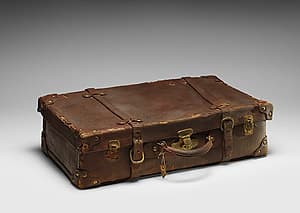

Marilyn Levine
Learn moreWaldo suitcase 1975
Purchased 1975
More detail | PermalinkMarilyn Levine’s clay sculptures, which persuasively imitate the appearance of leather objects in a super-realist style, brought her prominence in the 1970s. Her training as a scientist—she earnt a Master’s degree in Chemistry from the University of Alberta, Edmonton—informs her practice as an artist. She extends the possibilities of her material, manipulating clay to imitate other substances; the colours and textures are so accurate it is almost impossible to distinguish her works from the items they depict. Levine’s interest in metonymical objects—bags, jackets, belts and boots that stand in for an absent body—is ambiguous: ‘My work neither ignores human subject matter nor deals with it directly. Rather there is an implication of human absence which I like better.’[1]
Waldo’s suitcase, Johnston satchel and Sole leather (all 1975) are depicted with a minute, almost impersonal, exactitude. The objects are stained and partially glazed ceramic, modelled by hand, without the assistance of casting techniques. Levine achieves startling textural facsimiles, exploiting the qualities of clay and making works that are clever, witty and masterfully crafted.[2] There are holes, missing or damaged fittings, and handles shiny with human touch. Creases, folds and scratches record the object’s use over time, recalling the body and its presence.[3] The artist explained the attraction of leather:
more than any other material, it forms a record of its own history. It develops permanent wrinkles, it takes on the shape of the wearer, it records areas of abrasion and it records areas of soil. It therefore becomes an expression of time.[4]
In reproducing the appearance of worn rather than new leather objects, emphasising the scuffs and abrasions caused by everyday usage and wear, Levine creates a representation of human experience and activity.
Some of Levine’s works were inspired by items she was given by various family and friends. Waldo’s suitcase, for example, is probably titled after the artist’s younger brother, Robert Waldo Hayes.[5] As Maija Bismanis points out, by adding names to her titles, Levine’s works become ambiguously biographical.[6] We may be led to wonder how Waldo came to own this case. Where did Waldo travel with it and what was carried within? How did he lose the lower section of the brass clasp and what happened to the missing strap carrier? The commonality of human experiences, the act of owning and using objects, invites broader autobiographical readings.
The illusion of reality, and an inordinate attention to detail in Levine’s work, paradoxically creates an unreality that makes viewers question their own perceptions. The artist pushes us to examine these objects, not for their use, but for their form, texture and presence in reality. They in turn challenge us and bring about a heightened awareness of recorded history and experience.
Laura Webster and Robert Bell
[1] Levine, Norman Mackenzie Art Gallery, Regina, 1974, p 6.
[2] See Carol Donnell-Kotrozo, ‘Material illusions’, Journal of Aesthetics and Art Criticism, vol. 42, no. 3, March 1984, pp 277–82.
[3] Maija Bismanis, ‘Some fragmented thoughts about clay …’, in Marilyn Levine: A retrospective, Mackenzie Art Gallery, Regina, 1998, pp 11–25, at p 24.
[4] Levine, p 7.
[5] Waldo was Levine’s mother’s maiden name. Several other works of the period are associated with individuals, including Sid’s suitcase 1972 (Virginia Museum of Art, Richmond), John’s Mountie boots 1973 (Mackenzie Art Gallery, University of Regina collection) and Dufour backpack 1973 (then collection of the artist); the final work, as Gary Dufour advises, was based on his bag when he was Levine’s studio assistant in Regina; see NGA file 75/2610, folio139; see also http://www.marilynlevine.com/index.html, accessed 5 April 2018.
[6] Marilyn Levine, p 24.

